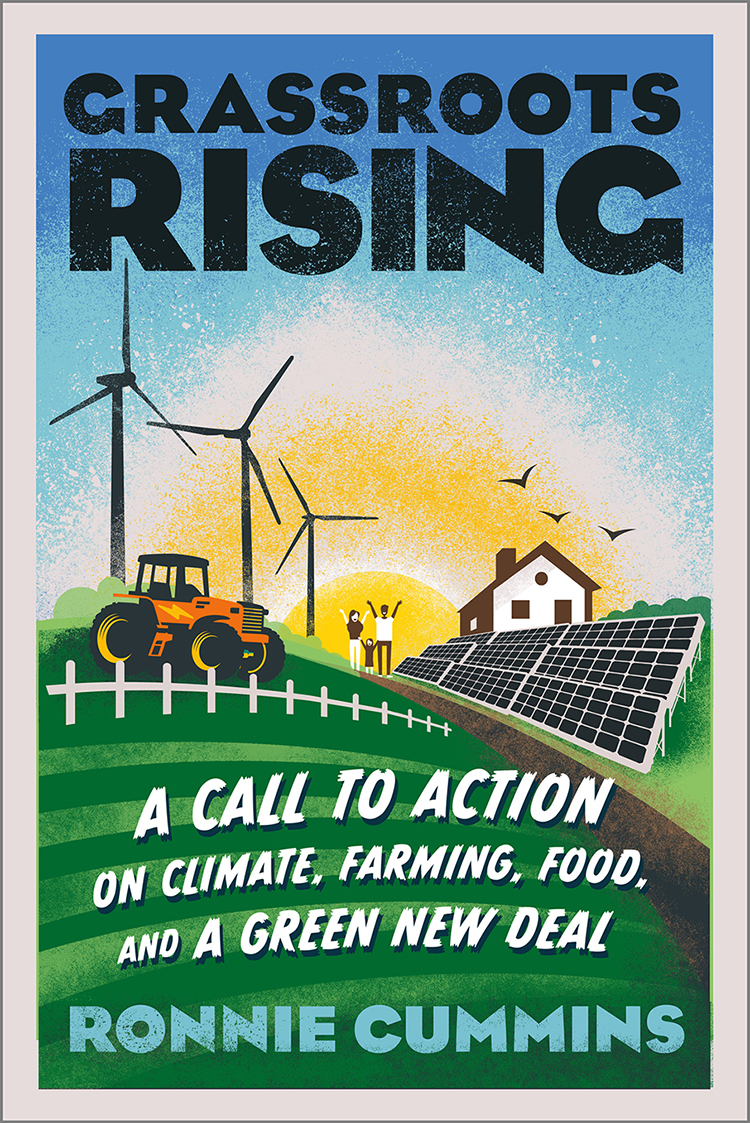
Grassroots Rising by Ronnie Cummins
reviewed by Maria Tzika
Grassroots Rising by Ronnie Cummins is a guide for practical solutions for climate change reversal and building grassroots movements. In his own words ‘a practical, shovel-ready plan of action for the USA and the world to transition to climate stability, peace, justice, health, prosperity, cooperation, and participatory democracy’. He is suggesting that we can achieve zero net emissions in ten years if we aggressively lower our current gas emissions and set a regenerative carbon drawdown. This might sound impossible to many, but Cummins argues for a very possible plan. So, what is it?
The plan is to achieve a 100% shift to renewable energy and regenerative agriculture, reforestation and silvopastoral agroforestry practices. While the mainstream is familiar with renewable energy and reforestation, the above-mentioned agricultural techniques are known to a limited few. According to the Rodale Institute, regenerative agriculture is a method of farming that ‘improves the resources it uses, rather than destroying or depleting them’1. Silvopastoral agroforestry is an ancient practice that integrates trees and pasture into a single system2. Cummins discusses how a strategy that combines these four different elements can reduce emissions, reverse global warming, and restore climate stability. The technology and the know-how are available, all that is needed, he argues, is to implement this strategy on a global scale.
The book is structured around four regeneration drivers. In order to regenerate our lands and food systems and prompt change on a mass scale we need to 1. raise grassroots awareness, 2. mobilise consumers and market demand, 3. change public policies, and 4. secure public and private investment for regenerative agriculture practices. Through his personal experience of campaigning and its impact on consumer attitudes and big companies’ interests, Cummins gives a lot of practical advice, which is quite energising. For example, regenerators are prompted to follow six simple rules, of which the first two are to highlight positive solutions and to connect the dots with people’s primary concerns. However, the urgency we are facing at this point and time to raise awareness and drive change is greater than ever before.
Awareness around the fossil fuel industry has increased in the last 10 years. For the most part consumers and citizens around the globe understand how most aspects of our lives are dependant on oil and gas extraction. The extraction and then constant burning of those depleting natural resources is the human contribution to global warming. But there is another factor that drives global warming and it lies right under our feet. Our current mode of food production has left most of our lands deforested, overgrazed, plowed under, and taken over by chemicals and GMO grains. Cummins points out that ‘we have disrupted our carbon, nitrogen, methane, mineral and water natural cycles to the point that our farmlands and pasturelands have become major greenhouse emitters instead of soil carbon sinks or repositories’. If we adopt regenerative agriculture, deforestation and silvopasture practices on a global scale, we will be able to restore the soil and the biodiverse ecosystem, and therefore allow the natural ability of plants and trees to draw CO2 from the atmosphere and store it in the soil.
Cummins goes on to describe what regenerative agriculture is, along with carbon farming, carbon ranching, plant diversification, biodiversity etc. – inspiring and important information that should be read and understood by farmers, environmental activists and consumers all around. He is inspired by the New Green Deal and the Sunrise Movement in the USA, acknowledging that the only way to succeed is with the support of the political body. The climate emergency demands mass political mobilization and fundamental change in public policies. The New Green Deal is a holistic approach that takes social and climate justice into consideration, but has been criticised as too radical and expensive to adopt. Biden has commited to re-joining the Paris agreement, but a lot will be determined by how he acts throughout his presidency. A lot of the work though, still lies with the grassroots. The communities have the power to eventually put regenerative food, farming and land use on the table for political discussion.
There is a lot to be done on a global and local level with regards to policy change and public investment. Fortunately, initiatives like 4p1000 and investment in renewable energy by big economies like China or India do exist. We as regenerators should keep pushing, collaborating and building networks and spreading the word. We should even approach public and private investors with profitable regenerative plans and endeavours. Fossils fuels are a non-renewable energy source, therefore a non-realistic long-term solution to energy needs. Degenerative farming is not only immoral but also ‘a bad investment if you think of the collateral damage to health, environment and social fabric’ as Cummins puts it.
This is a timely read. Cummins succeeds in raising awareness, inspiring his readers and providing positive solutions. A regenerative call to action, highly recommended to anyone that wants to find and communicate solutions for the climate, social and existential crisis we are facing. Regenerating the environment is regenerating our communities. Realising the potential of such solutions and tools can give us agency and conviction to enable this regeneration.
Notes
1. Rodale Institue (2014). Regenerative Organic Agriculture
and Climate Change [online]. Available at: https://rodaleinstitute.org/wp-content/uploads/rodale-white-paper.pdf [Accessed 20 Feb. 2021].
2. Jones, C. (2019). Silvopasture: Planting for Shelter & Forage [online]. Available at: https://www.agricology.co.uk/resources/silvopasture-planting-shelter-forage [Accessed 20 Feb. 2021].
Volume 4, no. 1 Spring 2021
